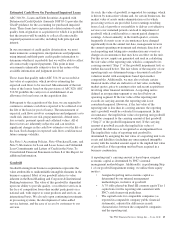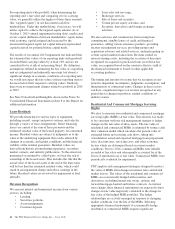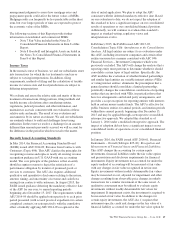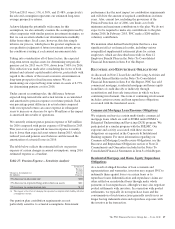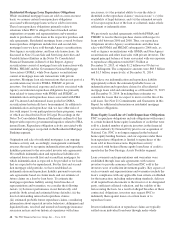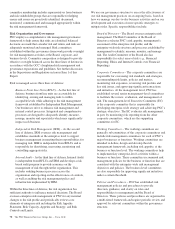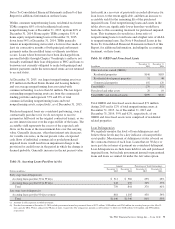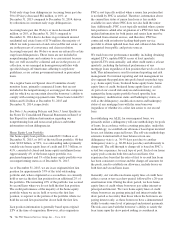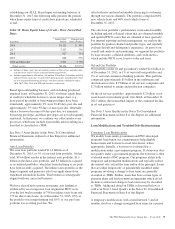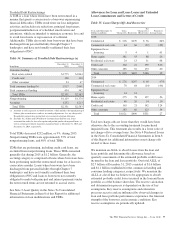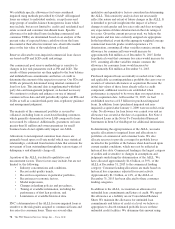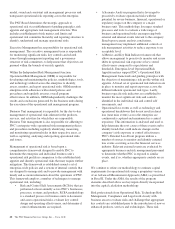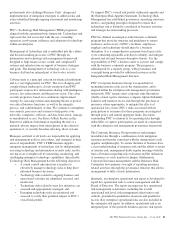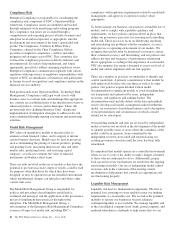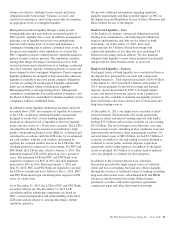PNC Bank 2015 Annual Report Download - page 91
Download and view the complete annual report
Please find page 91 of the 2015 PNC Bank annual report below. You can navigate through the pages in the report by either clicking on the pages listed below, or by using the keyword search tool below to find specific information within the annual report.
Notes To Consolidated Financial Statements in Item 8 of this
Report for additional information on these loans.
Within consumer nonperforming loans, residential real estate
TDRs comprise 68% of total residential real estate
nonperforming loans at December 31, 2015, up from 60% at
December 31, 2014. Home equity TDRs comprise 51% of
home equity nonperforming loans at December 31, 2015,
down from 54% at December 31, 2014. TDRs generally
remain in nonperforming status until a borrower has made at
least six consecutive months of both principal and interest
payments under the modified terms or ultimate resolution
occurs. Loans where borrowers have been discharged from
personal liability through Chapter 7 bankruptcy and have not
formally reaffirmed their loan obligations to PNC and loans to
borrowers not currently obligated to make both principal and
interest payments under the restructured terms are not returned
to accrual status.
At December 31, 2015, our largest nonperforming asset was
$33 million in the Real Estate, Rental and Leasing Industry
and our average nonperforming loan associated with
commercial lending was less than $1 million. The ten largest
outstanding nonperforming assets are from the commercial
lending portfolio and represent 37% and 8% of total
commercial lending nonperforming loans and total
nonperforming assets, respectively, as of December 31, 2015.
Purchased impaired loans are considered performing, even if
contractually past due (or if we do not expect to receive
payment in full based on the original contractual terms), as we
accrete interest income over the expected life of the loans. The
accretable yield represents the excess of the expected cash
flows on the loans at the measurement date over the carrying
value. Generally decreases, other than interest rate decreases
for variable rate notes, in the net present value of expected
cash flows of individual commercial or pooled purchased
impaired loans would result in an impairment charge to the
provision for credit losses in the period in which the change is
deemed probable. Generally increases in the net present value
first result in a recovery of previously recorded allowance for
loan losses, to the extent applicable, and then an increase to
accretable yield for the remaining life of the purchased
impaired loans. Total nonperforming loans and assets in the
tables above are significantly lower than they would have
been due to this accounting treatment for purchased impaired
loans. This treatment also results in a lower ratio of
nonperforming loans to total loans and a higher ratio of ALLL
to nonperforming loans. See Note 4 Purchased Loans in the
Notes To Consolidated Financial Statements in Item 8 of this
Report, for additional information, including the accounting
treatment, on these loans.
Table 30: OREO and Foreclosed Assets
In millions
December 31
2015
December 31
2014
Other real estate owned (OREO):
Residential properties $146 $183
Residential development properties 31 48
Commercial properties 102 120
Total OREO 279 351
Foreclosed and other assets 20 19
Total OREO and foreclosed assets $299 $370
Total OREO and foreclosed assets decreased $71 million
during 2015 and is 12% of total nonperforming assets at
December 31, 2015. As of December 31, 2015 and
December 31, 2014, 59% and 62%, respectively, of our
OREO and foreclosed assets were comprised of residential
related properties.
Loan Delinquencies
We regularly monitor the level of loan delinquencies and
believe these levels may be a key indicator of loan portfolio
asset quality. Measurement of delinquency status is based on
the contractual terms of each loan. Loans that are 30 days or
more past due in terms of payment are considered delinquent.
Loan delinquencies exclude loans held for sale and purchased
impaired loans, but include government insured or guaranteed
loans and loans accounted for under the fair value option.
Table 31: Accruing Loans Past Due (a) (b)
Amount Percentage of Total Outstandings
Dollars in millions
December 31
2015
December 31
2014
December 31
2015
December 31
2014
Early stage loan delinquencies
Accruing loans past due 30 to 59 days $ 511 $ 582 .25% .28%
Accruing loans past due 60 to 89 days 248 259 .12% .13%
Total 759 841 .37% .41%
Late stage loan delinquencies
Accruing loans past due 90 days or more 881 1,105 .43% .54%
Total $1,640 $1,946 .80% .95%
(a) Amounts in table represent recorded investment.
(b) Past due loan amounts at December 31, 2015 include government insured or guaranteed loans of $172 million, $120 million, and $765 million for accruing loans past due 30 to 59
days, past due 60 to 89 days, and past due 90 days or more, respectively. The comparative amounts as of December 31, 2014 were $220 million, $136 million, and $996 million,
respectively.
The PNC Financial Services Group, Inc. – Form 10-K 73


